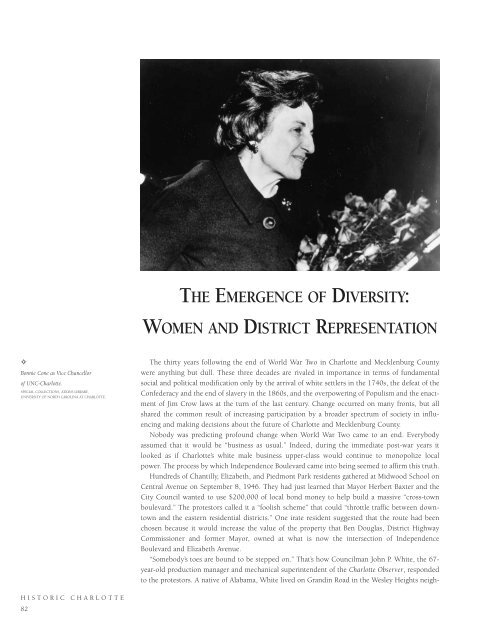Historic Charlotte
An illustrated history of the City of Charlotte and the Mecklenburg County area, paired with the histories of companies, families and organizations that make the region great.
An illustrated history of the City of Charlotte and the Mecklenburg County area, paired with the histories of companies, families and organizations that make the region great.
You also want an ePaper? Increase the reach of your titles
YUMPU automatically turns print PDFs into web optimized ePapers that Google loves.
THE EMERGENCE OF DIVERSITY:<br />
WOMEN AND DISTRICT REPRESENTATION<br />
✧<br />
Bonnie Cone as Vice Chancellor<br />
of UNC-<strong>Charlotte</strong>.<br />
SPECIAL COLLECTIONS, ATKINS LIBRARY,<br />
UNIVERSITY OF NORTH CAROLINA AT CHARLOTTE.<br />
The thirty years following the end of World War Two in <strong>Charlotte</strong> and Mecklenburg County<br />
were anything but dull. These three decades are rivaled in importance in terms of fundamental<br />
social and political modification only by the arrival of white settlers in the 1740s, the defeat of the<br />
Confederacy and the end of slavery in the 1860s, and the overpowering of Populism and the enactment<br />
of Jim Crow laws at the turn of the last century. Change occurred on many fronts, but all<br />
shared the common result of increasing participation by a broader spectrum of society in influencing<br />
and making decisions about the future of <strong>Charlotte</strong> and Mecklenburg County.<br />
Nobody was predicting profound change when World War Two came to an end. Everybody<br />
assumed that it would be “business as usual.” Indeed, during the immediate post-war years it<br />
looked as if <strong>Charlotte</strong>’s white male business upper-class would continue to monopolize local<br />
power. The process by which Independence Boulevard came into being seemed to affirm this truth.<br />
Hundreds of Chantilly, Elizabeth, and Piedmont Park residents gathered at Midwood School on<br />
Central Avenue on September 8, 1946. They had just learned that Mayor Herbert Baxter and the<br />
City Council wanted to use $200,000 of local bond money to help build a massive “cross-town<br />
boulevard.” The protestors called it a “foolish scheme” that could “throttle traffic between downtown<br />
and the eastern residential districts.” One irate resident suggested that the route had been<br />
chosen because it would increase the value of the property that Ben Douglas, District Highway<br />
Commissioner and former Mayor, owned at what is now the intersection of Independence<br />
Boulevard and Elizabeth Avenue.<br />
“Somebody’s toes are bound to be stepped on.” That’s how Councilman John P. White, the 67-<br />
year-old production manager and mechanical superintendent of the <strong>Charlotte</strong> Observer, responded<br />
to the protestors. A native of Alabama, White lived on Grandin Road in the Wesley Heights neigh-<br />
HISTORIC CHARLOTTE<br />
82
















